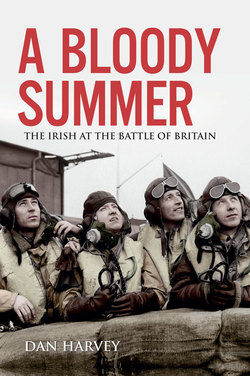Читать книгу A Bloody Summer - Dan Harvey - Страница 9
На сайте Литреса книга снята с продажи.
ОглавлениеAUTHOR’S NOTE
Flight Officer William Moore, an Irishman, married Cecilia Beck at St Peter’s Church, Over Wallop, Hampshire on 4 July 1940. Moore was a pilot of 236 Squadron and operated Blenheims throughout the Battle of Britain.
Among serving pilots and airmen, and later historians, the start and end date of the battle is disputed. Officially, it was from 10 July to 31 October 1940. There were 2,938 British, Allied and other airmen awarded the Battle of Britain clasp for having flown at least one sortie with an accredited unit of RAF Fighter Command during this time. The twin-engine Bristol Blenheim Mk IF aircraft, even then obsolete, were used as fighters by the RAF. These carried an observer and gunner in addition to the pilot – hence the term ‘airman’ is sometimes used as a catchall denomination. This is certainly the case for those named on the Battle of Britain Monument at Victoria Embankment, London, unveiled in 2005. Interestingly, William Storey Moore is not listed among the names of those coming from Ireland; instead he is found with those listed as coming from Australia. When the names of all Battle of Britain airmen were being drawn up for inclusion on the monument in 2004 and 2005, it was believed that he was an Australian from Melbourne.
However, in late 2012 Australian author and historian Kristen Alexander provided information that William Moore was born in Dublin on 21 November 1916, and educated there until 1932, whereupon he moved to Australia, continuing his schooling there until 1936. His father, William Moore, was from Dundrum, and his mother was from Dartry Road. However, he, ‘William Junior’, moved to England and joined the RAF on a short service commission in June 1937. During the Battle of Britain, 554 RAF airmen lost their lives; a further 795 were to die before the end of the war. William Moore was among the latter. He was killed on 24 December 1943 acting as squadron leader with 143 Squadron. His Beaufighter XI JM160 (the replacement for the Blenheim) broke up in the air – the cause unknown – while attacking a German Heinkel He 177 bomber over the Bay of Biscay. His widow, Cecilia Moore, moved to Melbourne sometime after his death.
In June 2019 I met with Edward McManus, a significant member of the organising committee behind the Battle of Britain Monument. During the course of collating the names of the participants to feature on the monument, he was relied upon to become familiar with them all through the records available. Today the monument’s website provides valuable biographical data, and even photographs, of these airmen; it is a highly useful source of information. With the goodwill, guidance and enthusiasm of Edward McManus, both of whose parents come from Ireland, it was possible to expand the list of Battle of Britain participants with connections to Ireland, and indeed those connected to the wider Irish diaspora, beyond the ten names which are presented on the monument itself under ‘Ireland’; it is this enlarged involvement that is presented here in this book.
RAF Fighter Command, symbolically represented in the public mindset by the Spitfire fighter aircraft, in fact possessed far more Hurricanes than Spitfires; the Hurricane was responsible for 80 per cent of enemy kills during the battle. Defiants, Blenheims and the airmen who crewed them also played their part. Fleet Air Arm Gladiators and Fairey Fulmars were involved, too. It also has to be remembered that there were far more RAF men and women on the ground than in the air; specialists of all kinds supported the airmen: ground maintenance crew, technicians, armourers, airfield defence, the RAF Police, the fire service and a host of others. And then there was Fighter Command itself, its own staff and those of the radar stations, anti-aircraft batteries, barrage balloons, the Royal Observer Corps and, eventually, air-sea rescue. The defence of Britain’s air space was multi-faceted and heavily populated.
Perhaps then, many of the myths ought to be seen for the fables that they were, and none more so than that there was little or no Irish contribution of note. There was, and this book is an acknowledgement of that truth. This book, for the first time, presents a fuller indication of the participation of those who have a connection to Ireland, whether they were born, educated, lived or had descendants on the island, or indeed were part of the wider Irish diaspora. The Irish were on the beaches at Normandy on D-Day; they were at the bridge at Arnhem during Operation Market Garden; they crossed the Rhine to engage in the final Battle of Berlin. They were in the cockpits with Fighter Command during the Battle of Britain.
